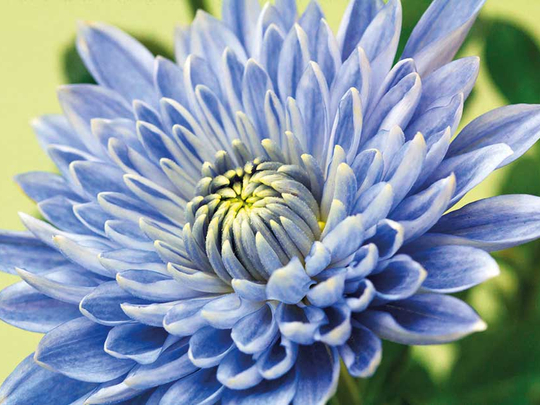
New York City: A blue human is a cold, dead or sad human. We don’t want to be blue. And flowers don’t appear to, either.
Less than 10 per cent of 400,000 floral species bear blue flowers. It’s unclear why. Pollinators such as blue flowers, after all. Humans do too — blue is our favourite colour, according to a poll by sociologist Philip N. Cohen.
Scientists and horticulturalists have tried to force blueness upon flowers, but breeding and genetic engineering hasn’t worked out, mainly because there are not many compatible plants with the genetic machinery to manufacture blueness.
Now Japanese scientists have finally created a true blue chrysanthemum — one that passes the strict colour standards of the Royal Horticultural Society. Chrysanthemums are usually pink, yellow or red. The scientists hope their methods, published Wednesday in Science Advances, can be used to blue-ify other flowers, like roses.
But their challenge also highlights one of nature’s lovely quirks: Why is blue so hard to come by in the first place?
“Plant species blooming blue flowers are relatively rare,” Naonobu Noda, a plant biologist at the National Agriculture and Food Research Organization in Japan who led the research, noted in an email.
It took Noda and his colleagues years to create their blue chrysanthemum. They got close in 2013, engineering a “bluer-coloured” one by splicing in a gene from Canterbury bells, which naturally make blue flowers. The resulting blooms were violet. This time, they added a gene from another naturally blue flower called the butterfly pea.
Both of these plants produce pigments for orange, red and purple called delphinidin-based anthocyanins. (They’re present in cranberries, grapes and pomegranates, too.) Under a few different conditions, these pigments, which are sensitive to changes in pH, can start a chemical transformation within a flower, rendering it blue.
The additional gene did the trick. It added a sugar molecule to the pigment, shifting the plant’s pH and altering the chrysanthemum’s colour. The researchers confirmed the colour as blue by testing its wavelengths in the lab.
What they did was already being done in nature: No blue flowers actually have blue pigment. Neither do blue eyes or blue birds. They all get help from a few clever design hacks.
Blue flowers tend to result from the modification of red pigments — shifting their acidity levels, switching up their molecules and ions, or mixing them with other molecules and ions.
Some petunias, for example, have a genetic mutation that breaks pumps inside their cells, altering their pH and turning them blue. Some morning glories shift from blue upon opening to pink upon closing, as acidity levels in the plant fluctuate. Many hydrangeas turn blue if the soil is acidified, as many gardeners know.
In vertebrates, blue colouring often is more about structure. Blue eyes exist because, lacking pigments to absorb colour, they reflect blue light. Blue feathers, like those of the kingfisher, would be brown or grey without a special structural coating that reflects blue.
Reflection is also the reason for the most intense colour in the world, the shiny blue of the marble-esque Pollia fruit in Africa.
Despite widespread blue-philia, the new chrysanthemums may meet a cool reception. A permit is required to sell genetically modified organisms in the United States, and there isn’t one for these transgenic flowers.
Officials are wary of transgenic plants that might take root in the environment, because of their possible effect on other plants and insects. Noda and his colleagues are working on blue chrysanthemums that can’t reproduce, but it’s unlikely you’ll see them in the flower shop anytime soon.












